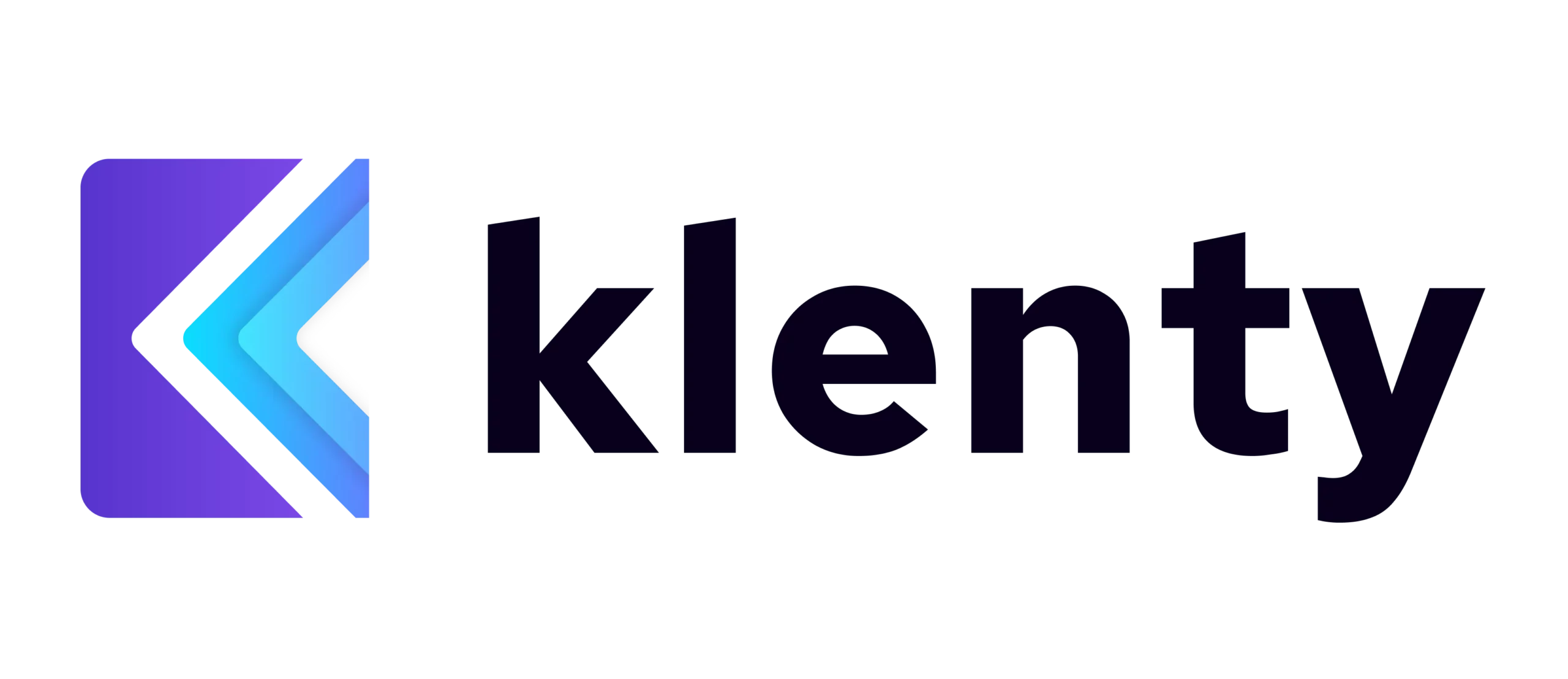It all started with a question.
Praveen, our Chief Revenue Officer, approached our sales team and asked, “What’s our prospecting mileage?”
Uh-oh.
Silence.
“I mean, how many meetings do we book per 100 prospects?”
We’d never considered this question before.
When we revisited our cadences, lists, and reports, we were shocked at the result.
Our meetings booked per 100 prospects were getting lower and lower.
We couldn't afford to burn through our prospect list just to book a few more meetings.
So, we dug further into our cadences, metrics, and processes.
That’s when we found a game-changing insight.
Different prospects interacted with us differently.
We discovered 3 kinds of prospects.
- Those who were unaware they faced a business pain Klenty could solve.
- Those who were evaluating solutions because their current sales process wasn’t working.
- Those who knew Klenty as a Sales Engagement Platform and showed consistent engagement with our outreach.
In short, prospects existed on different levels in the buying journey.
We had to change our strategy based on the prospect’s stage in the buying journey.
Our sales cadences were built to capture demand, but now we had to evolve them to create demand as well.
To achieve this, we came up with a 4-step strategy:
- Segment prospects based on their stage in the buying journey
- Create cadences catered to each segment
- Switch prospects between cadences based on engagement
- Scale highly personalized messaging across multiple channels
1. Segment Prospects Based on Their Stage in the Buying Journey
We started by grouping prospects based on their level of engagement — like email opens, replies, calls answered, and so on.
- Prospects that were most interested (replied to our emails and answered our calls with a positive outcome) were categorized as 'high-intent' prospects.
- Those that engaged with us moderately (read our emails and clicked all links) but not enough to book a meeting were put under 'medium-intent' prospects.
- The unengaged prospects were grouped as ‘low-intent’ prospects.
Using Intent Scoring, we defined when a prospect became hot.
2. Create Cadences Catered to Each Segment
Our previous cadences had to go.
We had to carefully curate new cadences considering the stages of the buying journey.
And this time, we had to ensure we covered all communication channels.
Our goals:
- Engage prospects where they’re most active
- Customize messages without losing scalability
- Deliver messages when prospects are most likely to see them
i) High-intent Cadence:
Since these prospects had already established interest in our brand, we took a more personalized and effort-intensive approach.
We built cadences rich with calls, voicemails, and text follow-ups.
Klenty’s Dialer enabled reps to place call after call in one click.
And dropping voicemail (which reps were initially reluctant to do) became easier when Klenty removed the grunt work.
Since most manual tasks were automated, reps saved around 2-3 hours every day to focus on actual selling activities. This time was spent on researching prospects to write well-crafted, highly-personalized messages.
After reps manually personalized emails, our response rates improved by 20%.
Our emails went from looking like this:
Hey {first name},I stumbled upon your LinkedIn and noticed you work at {{company}} as a {{title}}. Thought Klenty, a Sales Engagement Platform, would be a great addition to your team.Here is a small video of how Klenty works.Book a call with us if you are interested in exploring.To this:
Hey {first name},Noticed {{company}}'s sales team does rigorous prospecting and researching in their assigned region/market to build an effective sales pipeline. Is your team using all the channels available to strike and initiate a conversation with high-profile personas of companies you are prospecting? Klenty helps you reach out to your prospects through emails, calls, LinkedIn, text messages, and WhatsApp and increases the likelihood of response without endless tool switching.Schedule a call with us to know more.ii) Medium-intent Cadence:
We created a cadence with 10 email follow-ups for our 'medium-intent' prospects.
Our emails were equal parts informative and beneficial.
Here’s an example of an email we sent to a medium-intent prospect.
Hey {firstname},
I’m {your_name} from {your_company}. As an SDR, I know how difficult it is to craft the perfect cold email to get you a response.So, I’m sharing this e-book ‘Cold Email Templates’ which you can use to send emails that will boost your reply rates.Let me know if you found this useful.iii) Low-intent Cadence:
A gentler strategy was adopted for prospects who didn’t engage with our outreach.
LinkedIn became the go-to channel for contacting prospects who didn’t engage with our emails or calls.
LinkedIn conversations proved effective and helped us avoid inbox fatigue. We established a connection with potential prospects and shared something of value.
For example, we shared an e-book with cold email templates on LinkedIn.
And with this frame of reference, we contacted them by email.
This method increased reply rates from (previously) unengaged prospects by 23%.
Hey {firstname},I’m {your_name} from {your_company}. As an SDR, I know how difficult it is to craft the perfect cold email to get you a response.So, I’m sharing this e-book ‘Cold Email Templates’ which you can use to send emails that will boost your reply rates.Let me know if you found this useful.Klenty’s LinkedIn Execution boiled down all LinkedIn activities to one click. All reps had to do was check and approve messages/InMails or connect requests before sending them.
Emails had an upper cap of around 250-300 emails per rep to avoid being flagged as spam. Klenty also sent emails at random intervals to mimic human behavior. Custom links were used to track email engagement activities.
Klenty also ensured that we practiced safe LinkedIn outreach. All LinkedIn messages were sent at random intervals, as well. Reps were warned if they exceeded the limit when sending connect requests, InMails, or messages.
3. Switch Prospects Between Cadences Based on Engagement
Now that our cadences were up and running, we had to move prospects to the correct cadence — based on their engagement.
With Playbooks, we set up automatic triggers (like email replies, clicks, or call outcomes) and actions (like adding prospects to a different cadence or stopping the cadence).
Let’s look at an example.
Prospect Julia always read our emails and clicked 1 or 2 links. But she wasn’t answering our calls.
So, she had to be moved from the ‘low-intent’ cadence to the ‘medium-intent’ cadence.
We set up a Playbook for this scenario, which automatically moved Julia to the respective cadence.
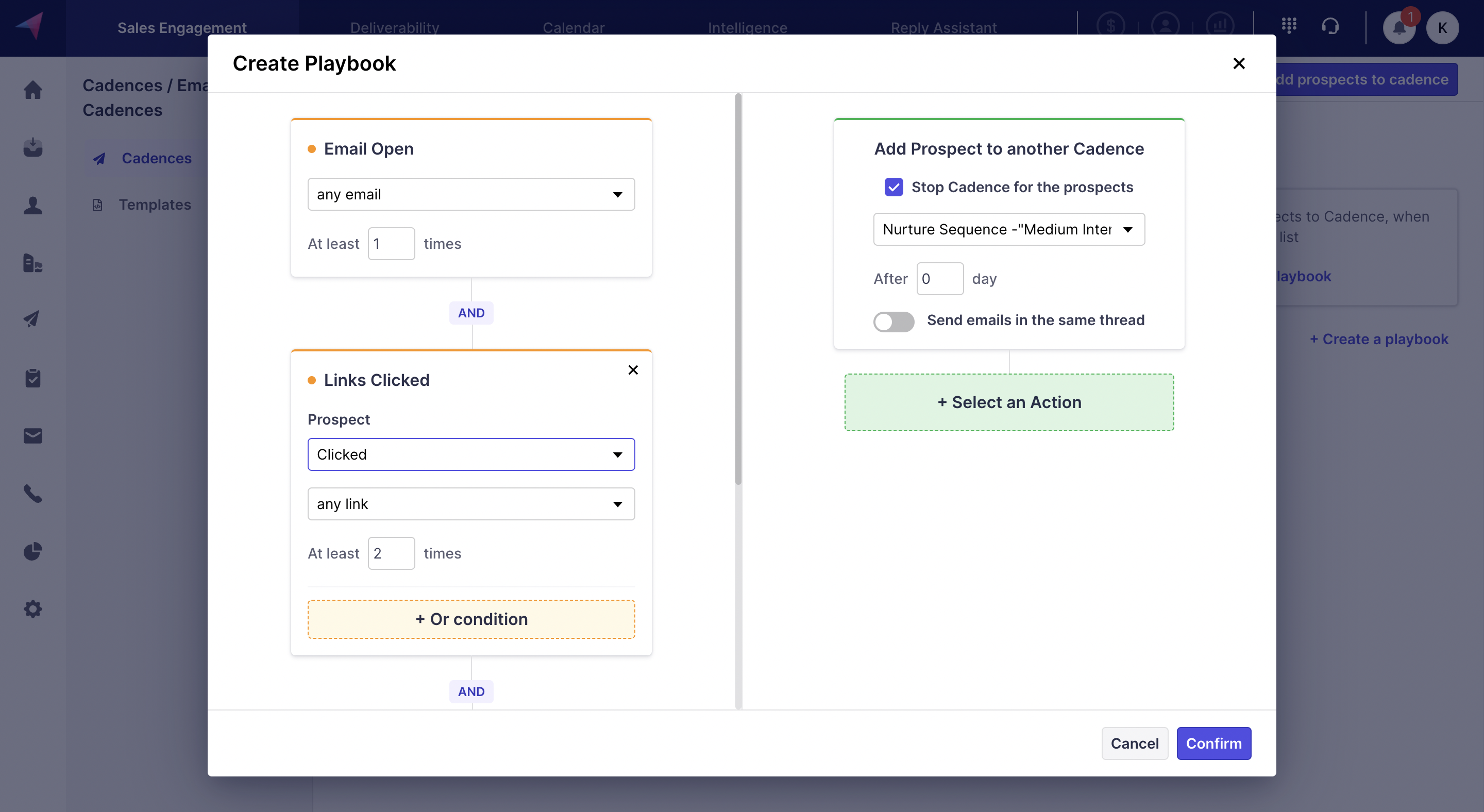
This wasn’t the only condition, though. With a combination of AND or OR conditions, our reps could activate Playbooks even for prospects who showed zero engagement.
This ensured that even if prospects showed no engagement this quarter, we were top of mind when their next buying cycle began.
i) Outcome-based Workflows for Calls
Calls were initially our main method of communication. But, our outreach wasn’t optimized to handle all outcomes for calls.
All that changed when Klenty’s Playbooks offered a range of conditions that enabled us to set up rules based on call outcomes.
Scenario 1: Prospect didn’t pick up the call
We set up a Playbook to write an email to begin a conversation.
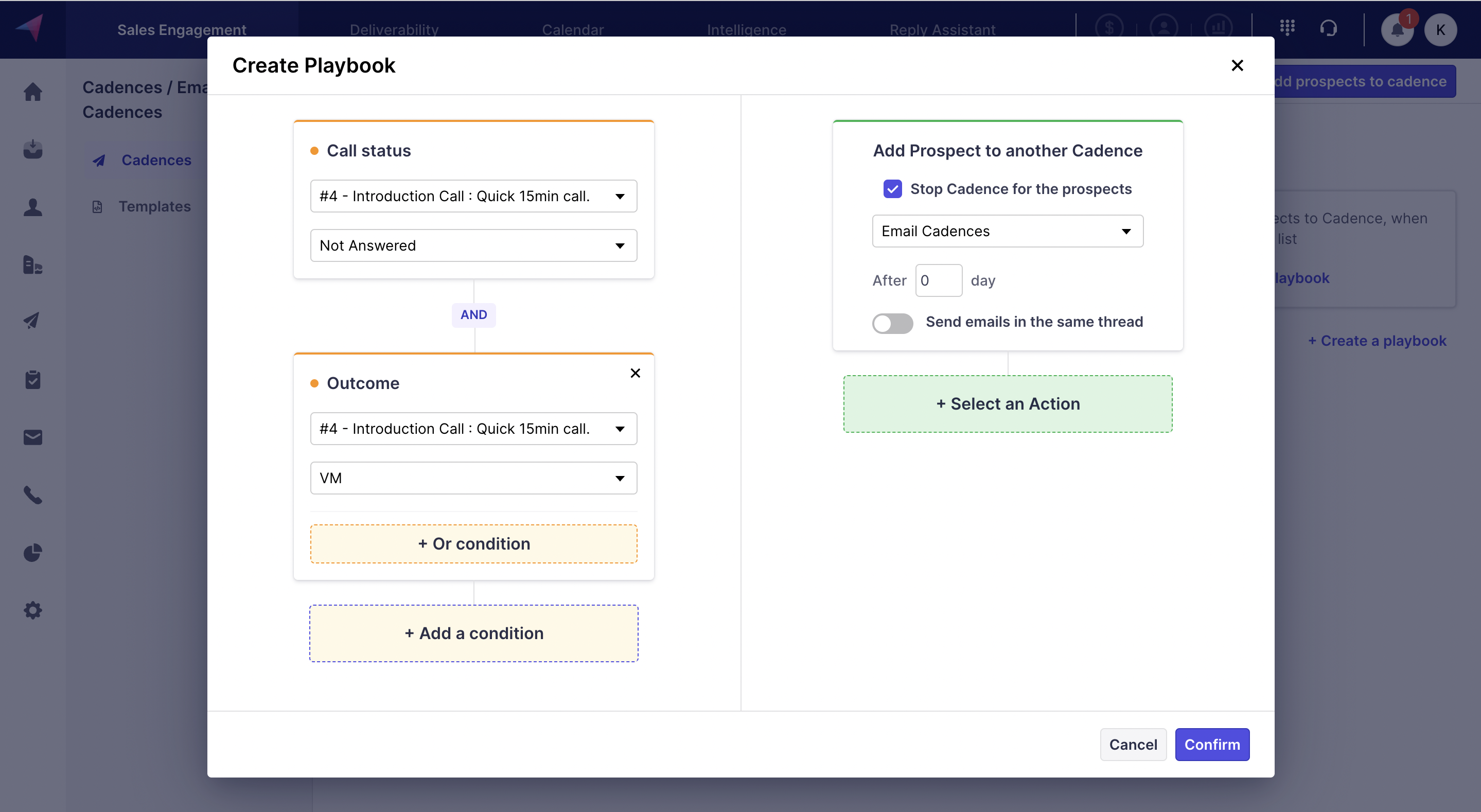
Scenario 2: Prospect answered the call, but the outcome was negative
We set up a Playbook to switch the prospect to a “Check-in cadence.” To avoid overwhelming prospects, we decided to follow up with them every quarter.
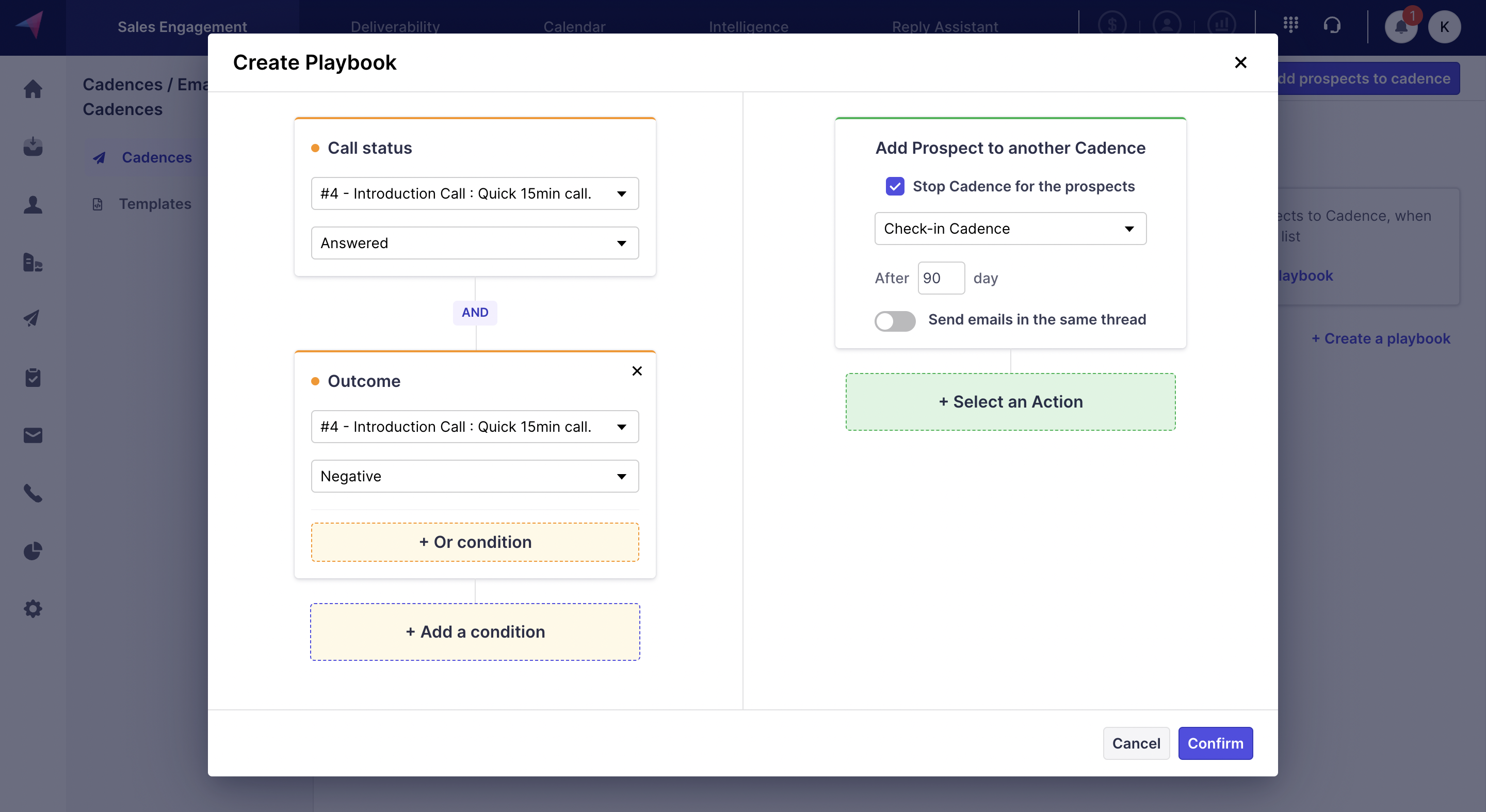
And the best part? All outcomes are customizable. We could set up our own outcomes and tailor workflows accordingly.
4. Scale Highly Personalized Messaging Across Multiple Channels
i) Scaling Highly Personalized Messaging
Personalization is key in any sales outreach.
As we were venturing into multiple channels, scaling personalization posed the biggest issue.
Klenty’s Personalization Engine pulled through here.
Reps weren’t restricted to placeholders. They were able to personalize based on date and time, as well.
And this spanned across all channels.
A major shift in our prospecting came in the form of visual prospecting. Our reps recorded themselves talking to prospects, and this made for some really engaging emails that captured attention.
Our messages went from boring and text-heavy to appealing and eye-catching. And our engagement rates rose by 34%.

ii) Executing the Right Activities at the Right Time
Being chaotic in our outreach before got us nowhere. We had to break down truckloads of tasks into smaller, executable chunks.
With Activity Center, our reps got their daily to-dos to execute. Reps could find their focus zone and tick off tasks that were due.
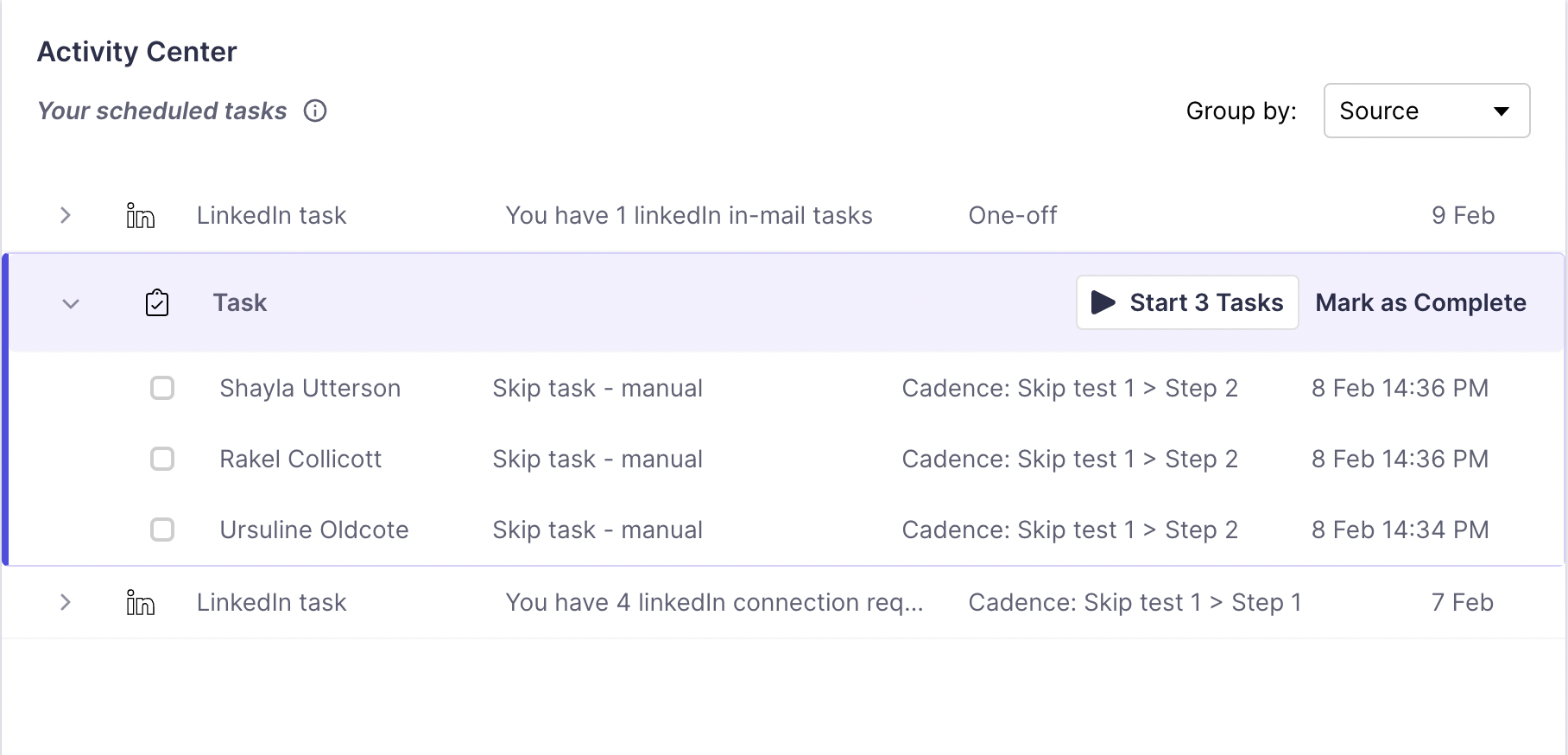
Replying to prospects on time was crucial. We fully capitalized on Live Feed. When we got a notification that a prospect had engaged with our outreach, we quickly responded to them.
But, switching between tabs to respond on different channels quickly became an issue. To tackle friction in the outreach, our reps adopted Multi-channel Inbox, where all communications across multiple channels were collated and ready at their disposal. We could reply to emails/LinkedIn messages and call from the same place.
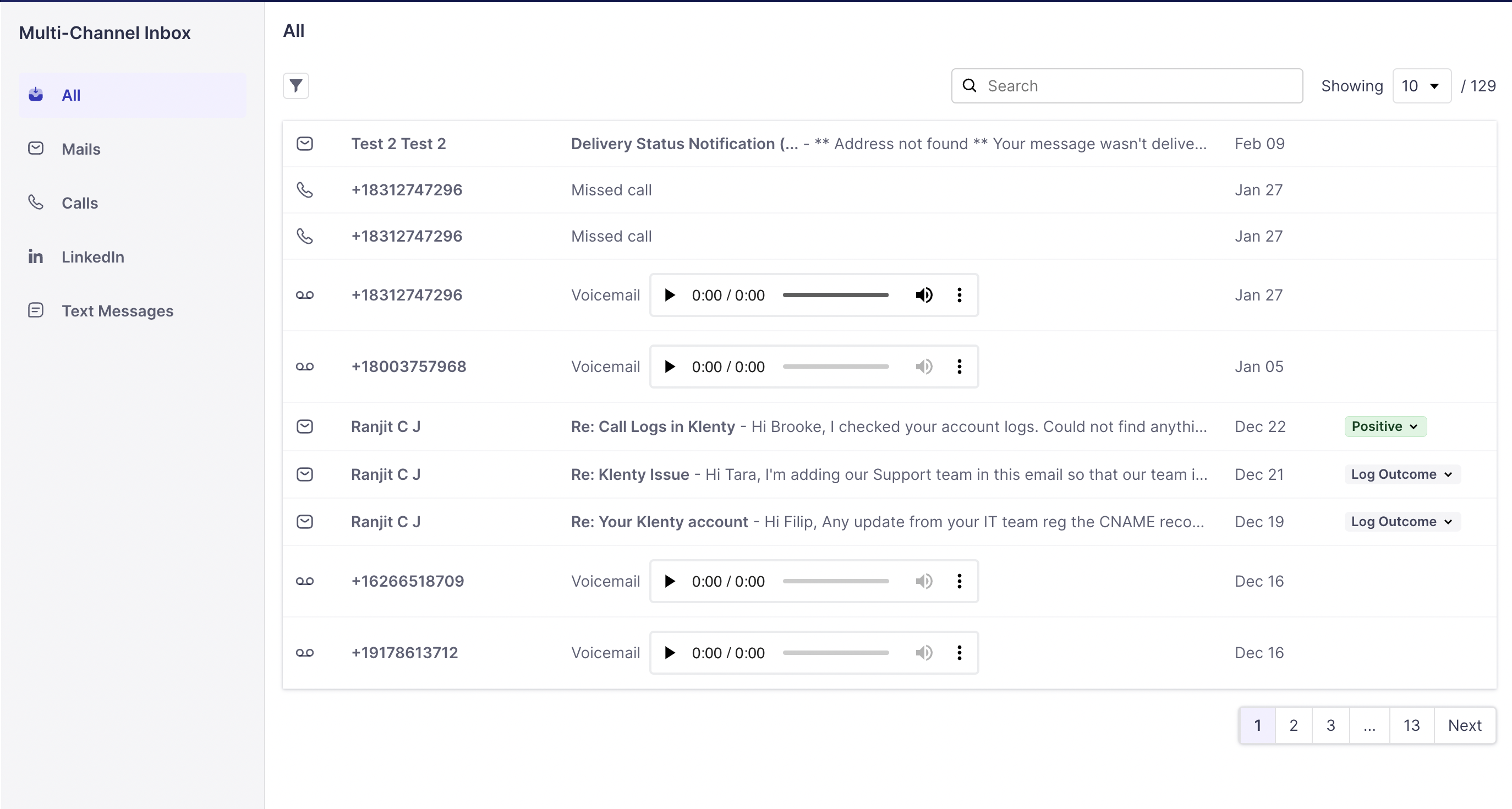
Finally, we ensured that all messages reached prospects exactly when they would see them — using Time-zone Detection and Delivery Windows.
Bonus: Keeping the CRM Updated at All Times
While we were concentrating on executing our new sales strategy, Klenty ensured that Pipedrive CRM was always updated.
Every conversation, email engagement (email opens, clicks, replies), call made, LinkedIn message detail, and text was recorded on Pipedrive instantly.
All new leads were automatically imported to Klenty as and when they appeared.
As a result, reps got an additional 15 hours weekly to focus on meaningful tasks rather than mind-numbing data entry.
To Summarize
Our main discovery after switching strategies was that our sales team had become too rigid. Reps had become disciplined at executing what their cadences told them to. We weren’t adapting to what prospects were telling us.
Upon executing our new strategy, we unlocked our true potential as a sales team.
We became proactive in our outreach instead of just reacting to prospect engagement. Our sales process became flexible and automatically adapted to prospects' buying journeys.
We call this process “Agile Selling.”
As a result, we could scale our meetings booked by 28%.

Agile Selling
Agile Selling is the process of adapting your sales outreach to what your prospects respond to, how they respond, and where they are more responsive. In a nutshell, you’re an agile seller if you let prospects take the wheel and guide you throughout the sales cycle.
